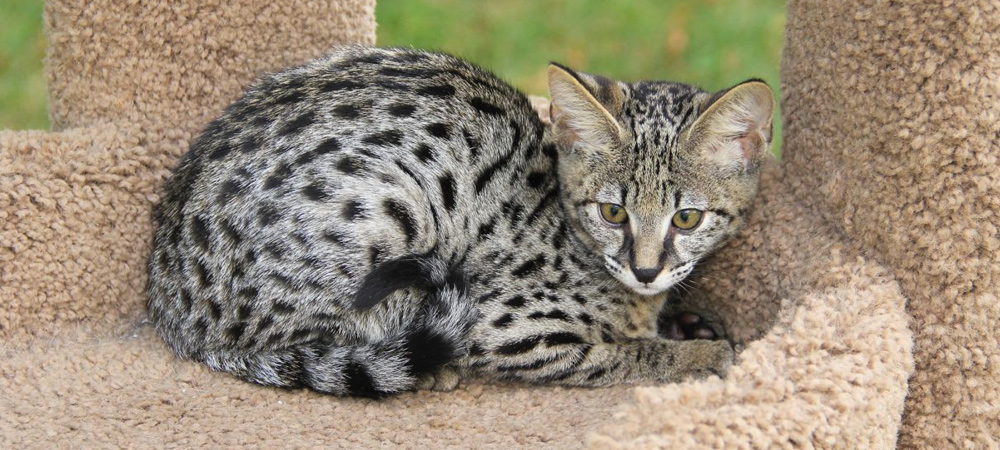Savannah Cat Overview
The Savannah, one of the most widely-known and sought after breeds of hybrid cats, is a cross between a domestic cat and wild cat- the African Serval. It can also be one of the most expensive breeds. Ranging between $900 to up to $20,000 depending on the the generations removed from its’ wild ancestor.
One of more exotic-looking hybrid breeds, the Savanna can weigh in at up to 25 pounds, jump 8 feet into the air, and many say has the personality more similar to a dog than a cat.
These beautiful, exotic and playful animals should have the disposition of a loving house cat, with the coloring and markings of a wild leopard. A sound temperament, without overt aggression, is essential in the domestic Bengal breed, given the closeness of its truly wild ancestors. Bengals are naturally inquisitive. They love to cuddle. Bengals are typically extremely affectionate and devoted to all members of their home. They can be wonderful pets, especially if children, other cats and dogs are already established in the household when the Bengal is introduced. The Bengal has a wide range of vocal sounds and frequently communicates through unusual but pleasing chirps, trills and cooing.
Adaptability
Affection
Child Friendly
Dog Friendly
Energy Level
Grooming
Intelligence
Health Issues
Shedding
Social Needs
Stranger Friendly
Vocalization
Enhancing the Savannah’s wild appearance is a short, slightly course coat that comes in several colors and patterns, including:
- Black
- Brown spotted tabby
- Black silver spotted tabby
- Black smoke
The coat can be spotted randomly or in horizontal patterns, or it can be marbled, with horizontal stripes arranged randomly on a lighter background. Some Bengals have a coat that is described as “glittered.” The fur shimmers in the light, as if it were tipped with gold dust.
The Savannah was developed after a domestic cat crossed with a serval — a medium-size African wild cat — gave birth to a kitten on April 7, 1986. The kitten was named Savannah. After hearing about her, breeders Patrick Kelly and Joyce Sroufe joined forces to create a new breed. Among the breeds that contributed to the Savannah’s development were spotted cat breeds such as the Bengal, Egyptian Mau and Oriental Shorthair. Outcrossing is no longer permitted now that the breed is established. The International Cat Association (TICA) began registering Savannah’s in 2001. The organization granted the breed full recognition — known as championship status — in 2012.
Savannah cats live longer than the average house cat, usually ranging between 17 and 20 years. Both pedigreed cats and mixed-breed cats have varying incidences of health problems that may be genetic in nature. Bengals are generally healthy, but the following diseases have been seen in the breed:
- Distal neuropathy, a nervous system disorder that causes weakness. It can occur in Bengals as early as 1 year of age. Fortunately, many cats recover on their own, although a few relapse.
- Flat-chested kitten syndrome, a deformity that can range from mild to severe. Kittens who survive to adulthood usually show no signs once they reach maturity.
- Hip dysplasia, which in severe cases can cause lameness
- Hypertrophic cardiomyopathy, a form of heart disease that is heritable in some breeds.
- Patellar luxation, a hereditary dislocation of the kneecap that can range from mild to severe. Severe cases can be alleviated with surgery.
- Progressive retinal atrophy, a degenerative eye disease.
It’s a good idea to keep a Bengal as an indoor-only cat to protect him from diseases spread by other cats, attacks by dogs or coyotes, and the other dangers that face cats who go outdoors, such as being hit by a car. Keeping him indoors also protects local birds and wildlife from this avid hunter. If possible, build your Bengal a large outdoor enclosure where he can jump and climb safely. Bengals who go outdoors also run the risk of being stolen by someone who would like to have such a beautiful cat without paying for it.


